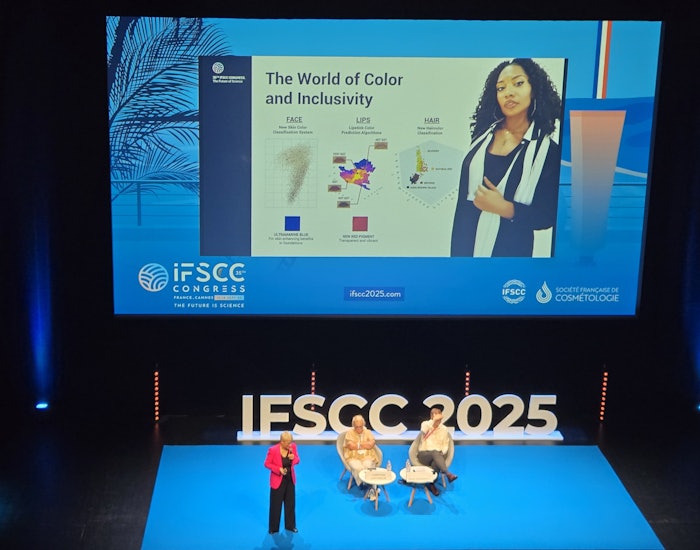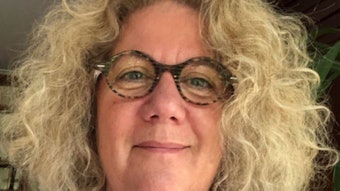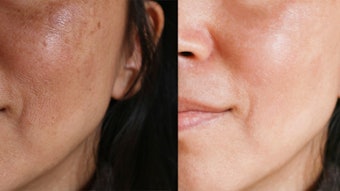
Diversity, personalization, sustainability and analytics, among other themes, headlined day three of the IFSCC 2025 Congress, held Sept. 15-18 in Cannes.
Sessions covered the science of skin and hair diversity, the integration of AI and omics for personalized solutions, and breakthroughs in sustainable formulations. Keynote presentations addressed the evolutionary diversity of human skin and the science of inclusive color.
 The closing dinner gala honored the efforts of past, present and future IFSCC Congress organizers and committees, and highlighted the best-in-show podium and poster presentations at this year's event.
The closing dinner gala honored the efforts of past, present and future IFSCC Congress organizers and committees, and highlighted the best-in-show podium and poster presentations at this year's event.
The glamorous closing gala celebrated the big winners of this year's Basic Research, Applied Research and Poster awards, as well as the Lester Conrad Education Prize winner and the French Society's (SFC's) young researcher award.
Out of the Box: No Such Thing as Artificial Intelligence
The day kicked off with a keynote by computer scientist, artificial intelligence (AI) expert and co-creator of Apple's Siri, Luc Julia, Ph.D., chief scientific officer of Renault Group, whose "Out of the Box" presentation proposed there is "no such thing as artificial intelligence."
The session challenged the common narrative surrounding AI to demystify it, separating Hollywood-fueled hyperbole from the real-world applications of machine learning and deep learning. Julia focused on the tangible potential of such technologies to benefit humanity, while cautioning against unrealistic promises that risk undermining genuine research and progress in the field.
Keynote: The Evolutionary Tapestry of Human Skin
 Nina Jablonski, Ph.D., of Penn State, explored the development of skin’s barrier functions, pigmentation and aging characteristics.
Nina Jablonski, Ph.D., of Penn State, explored the development of skin’s barrier functions, pigmentation and aging characteristics.
Esteemed anthropologist Nina Jablonski, Ph.D., of Penn State, presented a keynote on the diversity of human skin in "all its evolutionary glory." She explored the development of skin’s barrier functions, pigmentation and aging characteristics.
According to Jablonski, as humans dispersed into lower UV areas, they gradually lost pigment due to natural selection. However, these changes occurred through the actions "of divergent genetic suites," meaning the mechanisms of depigmentation differed across regions.
She also addressed the modern challenges of genetic admixture and urbanization, and the imperative to overcome historical biases in medicine and skin care to treat every individual more effectively.
"Skin classification by color has no real value," she said, explaining skin tone is really a gradient of traits. She also encouraged attendees to "eliminate the use of race names in your scientific work," adding, "we know precious little about working on functional variants in genomics."
Sustainability and Analytical Technologies
 Anita Coeurvolan, of the Institute Charles Gerhardt Montpellier (ICGM), the National Center for Scientific Research (CNRS) and National School of Chemistry Montpellier (ENSCM), explored plant-derived extracellular vesicles as a new active for skin health.
Anita Coeurvolan, of the Institute Charles Gerhardt Montpellier (ICGM), the National Center for Scientific Research (CNRS) and National School of Chemistry Montpellier (ENSCM), explored plant-derived extracellular vesicles as a new active for skin health.
Advances in sustainable formulations: Several presentations focused on eco-conscious innovation in cosmetic science. Themes included a method to assess rinse-off products that combines LCA with physicochemical properties analysis; the ability of a glycolipid and ceramide complex (both fermentation-derived) to improve hydration and nourishment to skin, hair and scalp; bio-resins upcycled from tomato skin to replace fossil-derived ingredients; and the potential of plant-derived extracellular vesicles as new active ingredients.
In addition, a dragon fruit-derived ingredient with a bio-inspired electroporation-like mechanism was described. The ingredient was chosen because: its electrolytes match that of the skin, it is capable of accumulating electrolytes while maintaining an acidic pH, and the ingredient has the capacity to generate electricity. Its unique composition was shown to act through a mesotherapy-device-like mechanism, stimulating P2XR and promoting the efficient intracellular delivery of bioactives. In vivo, the ingredient reduced wrinkle depth and under-eye bag volume while enhancing hydration, firmness and elasticity.
Innovations in analytical technologies and AI: The cutting edge of cosmetic evaluation and prediction were among several forward-looking podium talks. Research presented included the use of neural networks for facial translucency prediction, the application of omic skin histology with AI for complex skin analysis, and the development of machine learning models to forecast clinical research outcomes. Advanced methods for water visualization in the stratum corneum and lipidomics analysis for claim substantiation were also presented.
Satellite Symposium: Helena Rubinstein on Reconstructing Skin
 Day three of the standing-room-only Helena Rubinstein "satellite symposium" featured insights by Audrey Gueniche, Ph.D., and Maria Dalko-Cisba, Ph.D. (shown here), on how the company's Pro-Xylane (INCI: Hydroxypropyl Tetrahydropyrantriol) technology restructures facial skin.
Day three of the standing-room-only Helena Rubinstein "satellite symposium" featured insights by Audrey Gueniche, Ph.D., and Maria Dalko-Cisba, Ph.D. (shown here), on how the company's Pro-Xylane (INCI: Hydroxypropyl Tetrahydropyrantriol) technology restructures facial skin.
Day three of the standing-room-only Helena Rubinstein "satellite symposium," held on-site in parallel with the IFSCC Congress tracks, featured insights by Audrey Gueniche, Ph.D., and Maria Dalko-Cisba, Ph.D., on how the company's Pro-Xylane (INCI: Hydroxypropyl Tetrahydropyrantriol) technology restructures facial skin.
They presented the proven efficacy of a high 50% concentration of Pro-Xylane on five key biological dimensions for comprehensive aging repair:
- inflammation relief (-43% IL-1 α),
- epidermal reconstruction (+20% filaggrin, +86% syndecan and +188% Collagen XIII),
- dermal remodeling (+44% neutral GAG, +386% acidic GAG-HA and collagens: I +31%, III +18%, V +65%, XI +110%, VI +29%, XII +20% and XIV +20%),
- metabolic repair (+84% aconitase) and
- DEJ redensification (+141% perlecan, +119% integrin beta 4, collagens: IV +48%, VII +34% and XV +74%).
The session additionally described the synergistic effects with aesthetic procedures.
Keynote: The Science of Inclusive Color
Anke Hadasch, Ph.D., global vice president of color science métier at L'Oréal R&I, France, revealed a holistic approach to color, connecting art, science and technology to create high-performing, desirable colors for all skin tones. Her work covered multicultural beauty studies, disruptive and sustainable pigment technologies, cognitive color studies on lip products, and data-driven predictive formulation algorithms.
"Color is based on perception by the human eye," she explained, demonstrating how one's perspective of color changes simply by changing the background color, lighting and temperature. "We need to apply a holistic approach to color to deliver a seamless online and offline color experience," she noted.
She described a multicultural beauty face study that collected more than 10,000 datapoints to arrive at six skin tone classifications: very light, light cool, light warm, medium, deep and very deep. She also explained, for example, how blue pigments provide a closer match for darker pigmented skin tones. "We propose [these classifications] to be used as a new standard," she added.
Makeup, Fragrance and Personalization
Future-forward makeup science: Additional talks diving into color cosmetics introduced a microfluidic biomimetic skin model for characterizing sustainable powder alternatives, and a generative AI-based pipeline for advanced virtual makeup. Further discussions explored iterative clustering for lipstick visual perception, HS-GC-MS analysis for lipstick stability, and a historical analysis of lipstick color trends.
Fragrance science: Fragrance research presentations highlighted the use of CO2 alcohol to create fragrance, as well as sleep-inducing scents. In terms of sleep enhancement, one researcher explained how 1,925 aroma chemicals were scanned for their ability to act on the GABA receptor, which has calming effects; 132 were identified, and warm, soft and comforting notes showed the best effects. Examples of extracts acting on GABA included pine, lemongrass, agarwood, lavender (linalool) and sweet flag.
Personalization and beauty tech: Looking ahead, several papers described ways digital tech is driving personalized skin care. Topics included the application of a skin prediction algorithm for clinical outcomes, biometric-emotion driven 3D printing for personalized beauty solutions, and a novel method for objectively quantifying consumer-perceived ideal complexion from retouched selfies.
Aligned with the beauty tech theme, wrapping up the Congress, the French Society (SFC) awarded Alizé Vialle, a project manager at CTI Biotech, the Young Researcher Award for the, "world's first computer-connected lab grown human bioprinted skin with a sensory nervous system for instantaneous cosmetics and fragrance testing."
Closing Gala Celebrates Excellence in Innovation and Education
 Seoyeon Kyung, of COSMAX BTI R&I Center in Korea, accepted the Basic Research Award for the development of a stress-induced hair graying model using human hair-bearing organoids.
Seoyeon Kyung, of COSMAX BTI R&I Center in Korea, accepted the Basic Research Award for the development of a stress-induced hair graying model using human hair-bearing organoids.
After three full days densely packed with cosmetic science, the IFSCC Congress praesidium, delegates and attendees donned glamorous evening attire to celebrate scientific excellence and education. The closing dinner gala honored the efforts of past, present and future IFSCC Congress organizers and committees, and highlighted the best-in-show podium and poster presentations at this year's event.
The big winners included:
 Jolanta Idkowiak-Baldys, of L'Oreal USA, received the Applied Research Award for a paper on the roles of the scalp bacterial profile and ethnicity as determining factors in dandruff.
Jolanta Idkowiak-Baldys, of L'Oreal USA, received the Applied Research Award for a paper on the roles of the scalp bacterial profile and ethnicity as determining factors in dandruff.
- Seoyeon Kyung, of COSMAX BTI R&I Center in Korea, who accepted the Basic Research Award for the development of a stress-induced hair graying model using human hair-bearing organoids;
- Jolanta Idkowiak-Baldys, of L'Oreal USA, who received the Applied Research Award for a paper on the roles of the scalp bacterial profile and ethnicity as determining factors in dandruff; and
- Eisuke Taki, of Shiseido, who was awarded the Johann Wiechers Best Poster prize for a paper on understanding facial shape and unraveling non-genetic factors, along with the development of face shaping ingredients through gravity-responsive 3D facial imaging.
- In addition, the New Zealand Society of Cosmetic Chemists was presented the Lester Conrad Education Prize — a CHF 8,000 (approx. USD $10,096) reimbursement for various educational expenses, paid over three years.
 Eisuke Taki, of Shiseido, was awarded the Johann Wiechers Best Poster prize for a paper on understanding facial shape and unraveling non-genetic factors, along with the development of face shaping ingredients through gravity-responsive 3D facial imaging.
Eisuke Taki, of Shiseido, was awarded the Johann Wiechers Best Poster prize for a paper on understanding facial shape and unraveling non-genetic factors, along with the development of face shaping ingredients through gravity-responsive 3D facial imaging.
As the successes of IFSCC 2025 Congress was celebrated, organizers looked ahead to the 2026 and 2027 Congresses:
- Sept. 28-Oct. 1, 2026, in Perth, Australia, and
- Sept. 13-16, 2027, in Basel, Switzerland.
Mark your calendars.
Basic Research, Applied Research and Johann Wiechers Poster Award Finalists
 IFSCC 2025 Basic Research Award Finalists
IFSCC 2025 Basic Research Award Finalists
 IFSCC 2025 Applied Research Award Finalists
IFSCC 2025 Applied Research Award Finalists
 IFSCC 2025 Johann Wiechers Poster Award Finalists
IFSCC 2025 Johann Wiechers Poster Award Finalists










